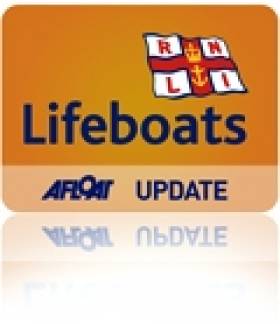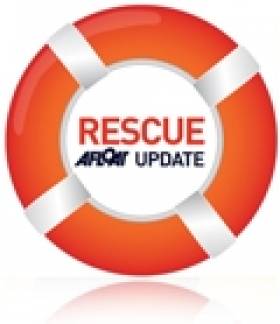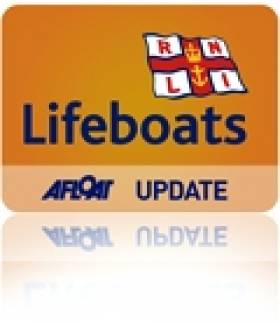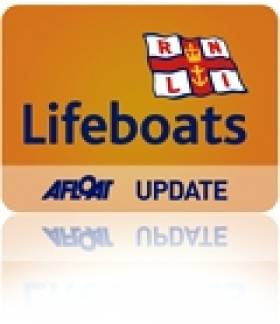Displaying items by tag: castletownbere
Navy Escort Detained Trawler to Castletownbere
Less then a month ago the Naval Service detained a Northern Irish registered fishing vessel the Lynn Marie seven miles east off Bray Head. Onboard was a crew of 4 UK nationals who were taken into custody to the Gardai after the trawler was escorted by the CPV L.E. Orla to Dun Laoghaire Harbour. To read more about this detention click here.
Ironically the L.E. Orla was a former Royal Naval vessel, HMS Swift (P241) which was deployed on her first assignment to the Hong Kong Patrol Squadron for a four-year period. In 1988 Margaret Thatcher's Conservative Party Government disposed HMS Swift and HMS Swallow (P242) to the Irish Naval Service. The pair were built by Hall Russell Shipyard of Aberdeen as part of an eight 'Peacock' class coastal patrol vessel (CPV).
The 'Peacock' pair were commissioned into the Naval Service and renamed L.E. Orla (P41) and L.E. Ciara (P42) in a ceremony attended by An Taoiseach Charles J. Haughey at the Naval Base in Haulbowline, Cork Harbour.
This weeks' detention is the second conducted by the Naval Service in 2011. Last year the Naval Service carried out 1,666 vessel boardings which resulted in 70 warnings and eight detentions.
- Irish Naval Service
- Cork Harbour
- Northern Ireland
- Haulbowline
- castletownbere
- naval service
- LE Niamh
- Royal Navy
- Ports and Shipping News
- Lynn Marie
- Fishery Breaches
- Fishery Detention
- Fishing Trawler
- Peacock Class
- Hong Kong
- Hall Russell
- Appledore Shipbuilders
- LE Orla
- HMS Swift
- LE Ciara
- HMS Swallow
- Margaret Thatcher
- Conservative Party
- An Taoiseach
- Charles J. Haughey
- Naval Base
Castletownbere Lifeboat Transfers Injured Man from Bere Island to Bantry in Blizzard
Lifeboat crew with Castletownbere RNLI launched this afternoon (Tuesday 21 December 2010) at 3.30pm to transfer a man from Bere Island to Bantry in West Cork after he was injured in a fall. The lifeboat crew had to step in after heavy snows made the roads in Bantry impassable and stopped the ferry running.
The man in his thirties was transferred onto the lifeboat at Bere Island and brought to Bantry to be met by a waiting fire brigade. The casualty was then brought to hospital for treatment. Conditions at sea were fair but with a very heavy snow falling.
Commenting on the callout Deputy Second Coxswain Paul Stevens said, "This was a callout in very challenging conditions. Due to the heavy snowfall in West Cork the roads in some places are impassable and travel is very difficult. We were delighted to be able to help out and ensure that the man was transferred quickly to receive emergency treatment. Our lifeboats are there to save lives wherever we can."
Related Safety posts
RNLI Lifeboats in Ireland
Safety News
Rescue News from RNLI Lifeboats in Ireland
Coast Guard News from Ireland
Water Safety News from Ireland
Marine Casualty Investigation Board News
Marine Warnings
Three Die in Cruiser Fire off West Cork
Three men are dead and a fourth has been injured after a boat went on fire and sank off the West Cork coast this evening. It happened in waters south of Roundcarrig Lighthouse off Adrigole Harbour, Bantry Bay. It is understood a serious fire broke out on the 25-foot cruiser. The RNLI lifeboat went to the cruiser's rescue at 5.45pm. There is no information currently about the type of cruiser involved.
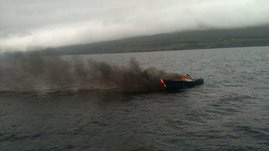
Photo: courtesy of Castletownbere lifeboat
A Coast Guard helicopter spotted the men in the water. The boat was on fire and sinking as they arrived.
The bodies of the three victims have been removed to hospital. It is understood all four men, who were in their 60s, were living in the Glengarriff area.
One of the victims is Irish and the other two men are from other European countries. A fourth man, who survived the incident, has also been taken to hospital.
The boat sank a short while later off Roancarrig, about seven miles from the fishing port. Conditions were calm at the time with some light fog in the bay, the spokeswoman said. Officials from the Marine Casualty Investigation Board will carry out an inquiry into the incident.
It is understood investigations will centre on whether an explosion in the engine caused the fire.
Press Release from RNLI:
Lifeboat crew with Castletownbere RNLI responded to a callout out this evening (Monday 16 August 2010) to a 25-foot cruiser on fire seven miles off the coast of Castletownbere, off Adrigole Harbour in Bantry Bay. The Shannon based Coast Guard helicopter was on scene and recovered four casualties from the water. Three were pronounced dead and one was taken to Cork University hospital for treatment.The Castletownbere all weather lifeboat was requested to launch at 17.41 hrs in calm conditions. On arrival at the scene the lifeboat volunteers witnessed the vessel on fire and the CG helicopter was recovering the casualties from the water. The Shannon based helicopter had been out on a callout and was in the area. The lifeboat was designated on scene commander and stayed on scene until the burning cruiser sank.
Castletownbere Lifeboat was launched this afternoon at 12.20pm to go to the assistance of a 43 ft fishing vessel taking on water 17 miles south west of Castletownbere in county Cork. To view the RNLI Video scroll down to the bottom of the post.
When the lifeboat crew arrived on scene they saw that the three crew had got into a liferaft as their fishing vessel was taking on a considerable amount of water and was in danger of sinking.
Conditions were described as fair with a large 4 metre groundswell. The Coast Guard helicopter from Shannon winched two of the fishing crew off the liferaft but a third man was in the water. Castletownbere lifeboat crew immediately recovered the man onto the lifeboat. With the casualty safely on the lifeboat, two RNLI crewmembers brought a salvage pump on board and proceed to pump the water from the fishing vessel. It was then taken under tow by the lifeboat and brought back to the harbour.
The rescued man did not need any further medical attention. The Irish Navel vessel the LE Eithne was also on scene during the rescue. Commenting on the callout Castletownbere RNLI crewmember Paul Stevens said, “ This callout thankfully resulted in a happy ending with three men being brought to safety. We were also able to bring the fishing vessel ashore in one piece. I am sure the three men are in shock but they had a lucky escape.”


Related Safety posts
RNLI Lifeboats in Ireland
Safety News
Rescue News from RNLI Lifeboats in Ireland
Coast Guard News from Ireland
Water Safety News from Ireland
Marine Casualty Investigation Board News
Marine Warnings
Castletownbere RNLI Gets Go-Ahead for New Station
The announcement was made during a visit of architect Gordon J. Philip and RNLI Divisional Inspector Martyn Smith to the proposed site of the new lifeboat station in Castletownbere, County Cork. The station is being built on reclaimed land, which was given to the charity by the Irish Government. The cost of building the station will be in the region of €600,000 and will include crew changing facilities, meeting and training rooms and a workshop. There will also be a lifeboat shop where members of the public can purchase lifeboat souvenirs.
All materials to be used in the building are being sourced from Irish suppliers and the station has been designed to the highest standards. Work is scheduled to begin in September 2010 and due to be completed in thirty weeks.
The station has been operating out of temporary facilities on Dinish Island and it has meant that the lifeboat crew, who are largely based in the town, have had to travel to there and then reach the lifeboat by boarding boat. The new arrangement will see them assemble at the station on the quayside and board the lifeboat directly from a pontoon, which will cut launch times by up to five minutes.
Commenting on plans for the new lifeboat station Brian O’Driscoll, Coxswain with Castletownbere RNLI said, “This lifeboat station will make a huge difference to the crew. We expect to be able to cut around five minutes off our lifeboat launching time, which will mean a faster response time to emergencies. Paul Stevens, Deputy Second Coxswain added that “with the lifeboat being directly accessible from the pier we will be able to land casualties ashore, allowing us to handle serious situations with sensitivity and privacy.”
Scottish architect Gordon J. Philip has already designed seven RNLI lifeboat stations but Castletownbere will be his first in Ireland. Gordon who is from a fishing family is a former RNLI volunteer with Macduff RNLI, having spent four decades involved as lifeboat crew and station management. He is very aware of the need for the lifeboat crew to have proper facilities and for the station to be an important and aesthetically pleasing part of the community it is housed in. Gordon said, “I want this lifeboat station to be a landmark in the town for all the right reasons. We will be building on land that didn’t even exist last year and giving the lifeboat crew of the Annette Hutton a sheltered and secure home at the front of this beautiful town.”
At the formal opening of the RNLI lifeboat college in Poole in 2004 Queen Elizabeth and The Duke of Edinburgh met the Castletownbere crew members and departed the College on Castletownbere’s lifeboat Annette Hutton.



























